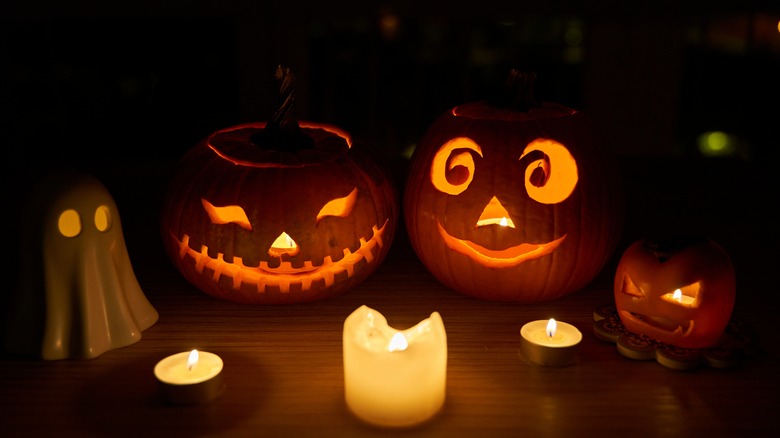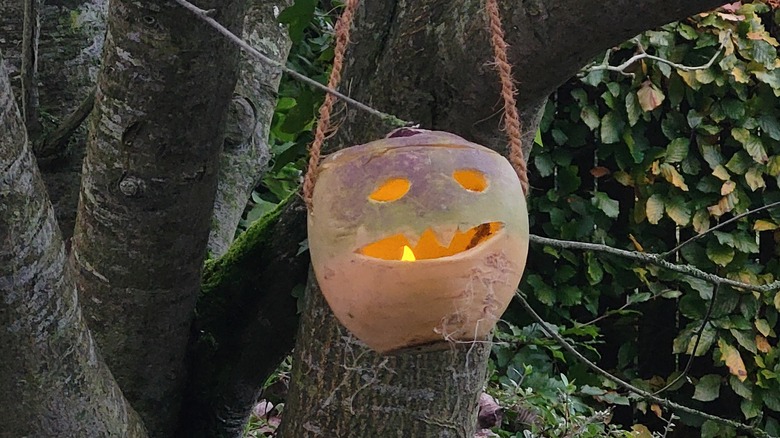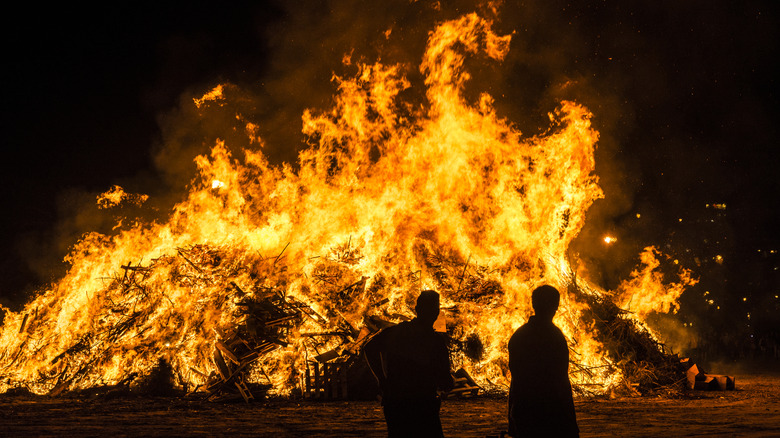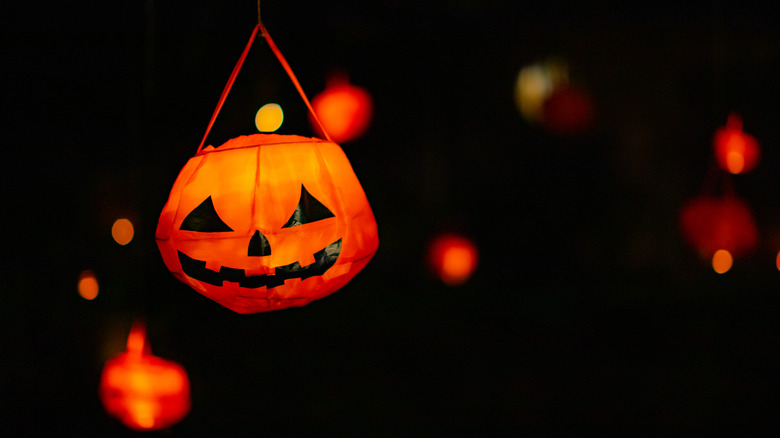The First Jack-O-Lanterns Weren't Made Out Of Pumpkins
Whether you're carving a fresh pumpkin at the kitchen table or just changing your plastic pumpkin's battery pack, it is clear that Jack-O'-Lanterns are a beloved and ubiquitous piece of autumnal decor, welcoming a stream of costume-clad trick-or-treaters on Halloween. But, unfortunately, for all of the pumpkin lanterns' charm, it isn't exactly historically accurate.
The use of pumpkins for Jack-O-Lanterns is a relatively recent phenomenon, beginning when Irish Immigrants came to North America in the 19th century. Back in Ireland, Jack-O'-Lanterns were carved from gourds, turnips, or potatoes, as the North American native pumpkins were not widely available in the Island nation. When Irish immigrants came to America in the 19th century, they found that turnips were less plentiful, so they instead carved pumpkins when making their Jack-O'-Lanterns. In addition to being more widely available, the fruits were easier to carve, so the tradition stuck. Plus, pumpkins make for a better treat than turnips; just look to pumpkin pie, pumpkin bread, and other much beloved pumpkin-spiced products.
Since then, pumpkin lanterns have become inextricably linked with Halloween, and the original turnip lanterns have turned into a dim memory. All the same, it might be worth illuminating the rich history behind the lanterns, and the stingy man that is their namesake.
Turnip are replaced with pumpkins
Jack-O'-Lanterns need no introduction. You can find pumpkin faces on sweaters, bags of Halloween candy, throw pillows, and carved in plastic in pretty much any craft store starting in August (or maybe even July). However, if you were to glimpse the face of an early Jack-O'-Lantern, you might find few similarities.
For starters, Jack-O'-Lanterns weren't always carved from pumpkins. In fact, in Ireland (where they originate), Jack-O-Lanterns were once carved from smaller vegetables such as turnips. The faces carved into these vegetables were simple and often scary, used to ward off evil spirits or a man named Stingy Jack, depending on which history you follow.
Originally, these turnip lanterns weren't lit with a candle but with coal or embers, and their use extends back over many centuries to Pagan rituals central to the holiday of Samhain (and later Halloween). They represent a totem of protection from the thinning of the veil between the living and the dead, or so legend says.
From the fires of Samhain
To understand Jack-O'-Lanterns, you must first understand the history of Halloween, which begins, of course, with the pagan holiday of Samhain. Before Catholic colonists took hold of Ireland, Celtic cultures were prevalent throughout the island nation. The Celtic peoples of Ireland celebrated the holiday known as Samhain. In ancient times, this holiday was one of four fire-based holidays celebrated by the Celtic people.
Samhain celebrated the close of the summer harvest and the beginning of the Celtic New Year. The holiday was celebrated with the lighting of a communal fire, from which people would take smaller flames back to their homes. The holiday spanned three days and three nights, during which it was believed that the barrier between the living and dead was thinned. Mythical creatures were said to roam the countryside in search of vulnerable humans. Lanterns were created out of vegetables such as turnips, with faces resembling these creatures carved on the front, and often used to ward off the impish creatures.
But how did Samhain turn into Halloween? Well, it began with the spread of Catholicism to Ireland. It was then that the holiday of Samhain merged with the Catholic holiday of All Hallows' Day (or All Saints Day). Since Samhain was celebrated on October 31st and All Hallows Day falls on November 1st, the holiday soon became known as All Hallows' Eve, which was then shortened to Halloween.
The legend of Stingy Jack
So now that we know how the lanterns got their faces, it's time to talk about their name. The term Jack-O'-Lantern originates from an 18th-century Irish folk tale about a man named Stingy Jack. The story goes that Stingy Jack, a man of no scruples and little character, had drinks with the devil and skipped out on the bill. For this slight, the devil refused to admit him to hell upon his death, and he wasn't welcome at the pearly gates of heaven, either, so Jack was left to wander around the world for eternity. So, how do Jack-O'-Lanterns relate to this folk tale? Well, there are two main narratives.
One goes that scary faces were carved into turnips and gourd lanterns and set into home windows to ward off the doomed Stingy Jack. Another conflicting legend portrays Jack as a wandering soul, carrying a fire-lit carved turnip as his only light. The lantern-carrying Jack was then known as Jack of the Lantern, which was later shortened to Jack-O'-Lantern. And the name has endured, even past the popularity of that dastardly Stingy Jack. You can still see his effigy glowing on many doorsteps during October. You might want to light one yourself, lest you be visited by Jack himself.



